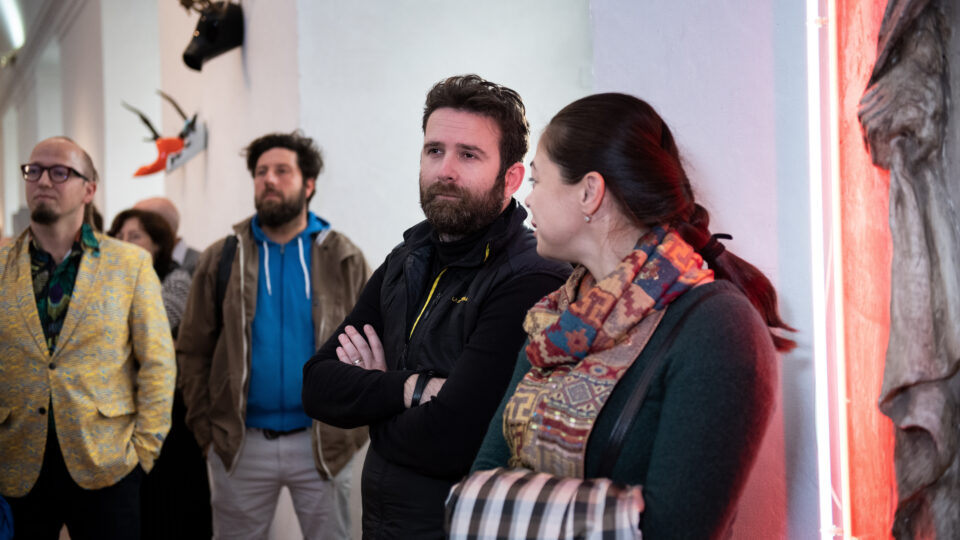This joint exhibition by Kateřina Adamová (1977) and Pavel Šimíček (1981) establishes a specific space for an at times pointedly concentrated dialogue that emerges from the intersections of various themes but that is simultaneously shaped by a narrative structure and the chosen form of the exhibition. The character of the exhibition perfectly matches the architecture of the exhibition space: two enclosed spaces illuminated by the monumental corridor of the northern wing of the former Jesuit College, plus the building’s exterior. This arrangement allows the viewer to experience a particular rhythm characterized by the alternating intensity of contemplation and taking in the dynamic nature of the works. Kateřina Adamová primarily creates with drawings on paper, while Pavel Šimíček works mostly with three-dimensional objects, but these two artistic approaches stimulate one another thanks to various overlaps: Adamová’s figural scenes made using short, thick strokes of coloured pencils make a highly sculptural impression, while the physical volumes and lines of Šimíček’s objects, some of which are composed directly into real architecture, are of a drawing-like character.
On a basic level, Adamová’s works can be read as a personal commentary on everyday existence. Combined in extensive cycles, they produce a story. We can sense the complicated states of mind that force her to produce a fundamentally personal body of work. The depicted situations are almost physically tangible; they assault the viewer’s imagination and arouse our emotions. The strokes are precise, almost realistic, but her figural scenes are not rooted in any particular space. The shapes, emphasised by stitching, are anthropomorphous and occasionally reminiscent of art informel. At times, they are lively, full of tension, prepared to engage, capable of sudden bitter humour. The artist’s inner process also involves the idea of breaking free, of departing, of leaving behind given reality by aiming for the sky. Reality presents the individual with various different situations, and the necessity of experiencing them arouses a sense of absurdity and of finding a way out. The drawings become a witness to mental transformation – the figures are depicted very realistically but are immersed in an intimate space.
Pavel Šimíček’s objects – at first glance clear and precise – also make a somewhat unsettling impression. They reflect the artist’s interest in the fractal multiplication of an element to create a structure. Fragments characterized by an identical architectural principle can then be separated from the coherent core, for instance in the form of a three-dimensional architecture consisting of vertical segments – hexagonal prisms resembling palisades of magmatic basalt. At the same time, they contain the meaning of breaking free from the laws of gravity – they deny them, in fact. Pavel Šimíček seeks a shape that, in his own words, ‘will cause matter to levitate’. Some of his objects reflect a fascination with the phenomenon of an omnipresent structure permeating its surroundings. They take on the form of linear objects possessing the expressiveness of sharp angles; they pass through space, sometimes hidden. They hint at the intuited existence of phenomena, occasionally also at a kind of deviation from order. Pavel Šimíček is also interested in producing a technical record of a living process, and so he translates lines resembling a graph into aesthetically perfect three-dimensional objects.
In both artist’s forms of expression, we can sense danger and exact precision, but also fragility and irrationality. In fact, their art is characterised by precisely this ability to harness and recast extreme situations into an expressive style possessing its own specific vitality. As a result, their art can come together in an inspirationally significant manner despite their very different use of media. Both artists express a sense of inherent extremity and escapist romantic imagination. Their works thus establish a living space characterized by permanent mutuality and shared characteristics.
Iva Mladičová












